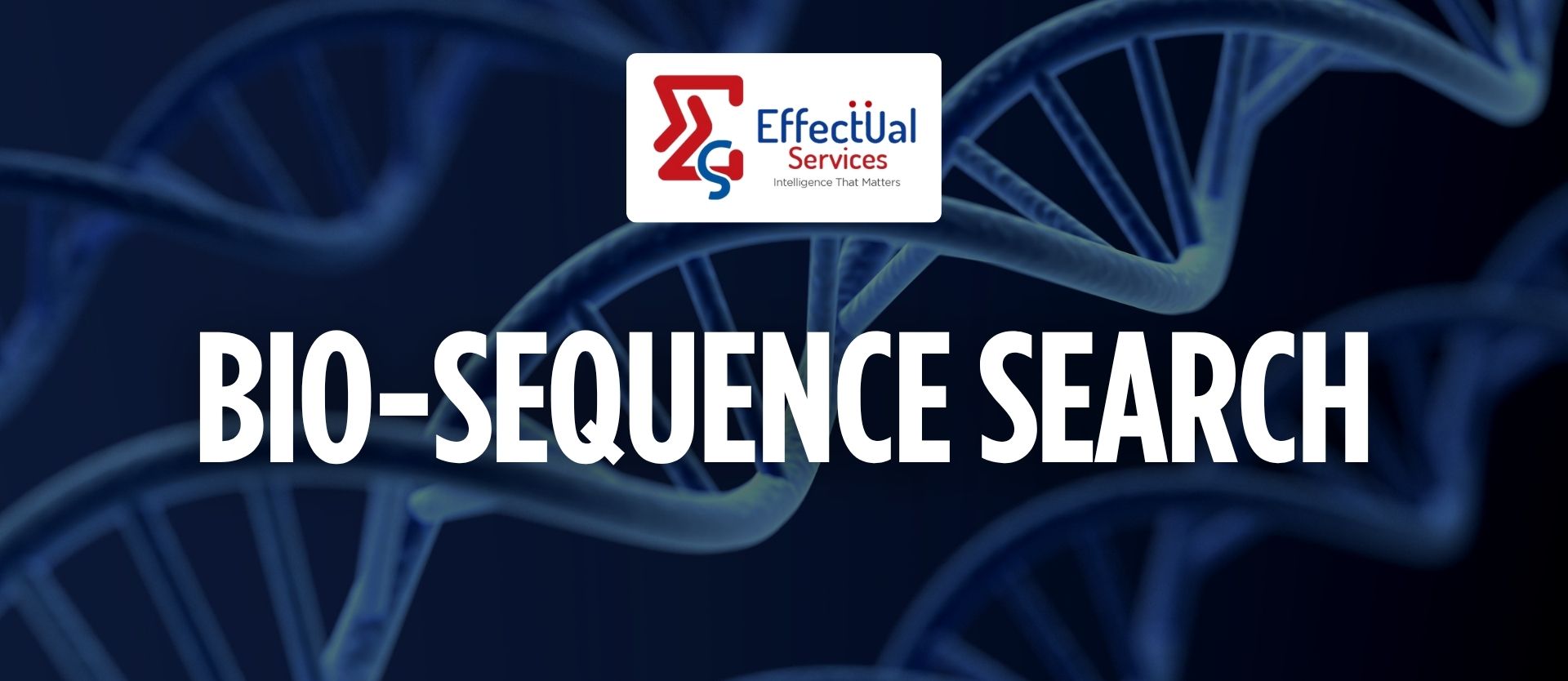Bio-Sequence Search Services | DNA, RNA & Protein Analysis

Biological Sequences include DNA/RNA nucleotide sequences or amino acid sequences of protein. Searching for Bio-sequences includes finding a specific arrangement of sequences in a given patent or non-patent document. Sequence search helps the inventors to ascertain whether the sequence is novel or not. Since the novelty of the sequence lies in the unique combination of nucleotides or amino acids, a keyword-based search alone cannot capture the entire data-set, including all the relevant results. Even if the desired sequence has a common name, not all patents would include the name, and thus a number of such results may be missed during the keyword-based search.
Some of the key tools used for sequence searching are: STN (Scientific Technical Networks), which is a network of more than 200 databases, BLAST searching, etc. Sequence searching requires deep domain expertise in databases, such as STN.
We at Effectual Services have a team of Bio-technology experts who specialize in sequence searching. Over the years we have developed an in-depth understanding of the workings of these databases and have derived strategies to derive the expected output within a minimal budget.
The major elements of a bio-sequence search are:
- Bio-sequence: The search query commonly starts with a representation of the Bio-sequence that is normally submitted in the format of FASTA Format that signifies the composition of nucleotides or amino acids. One single Bio-sequence may involve many sub-sequences. Like having a heavy constant sequence and heavy variable sequence that are embedded inside the heavy chain sequence of an antibody.
- Search Algorithm: Bio-sequence search is dependent on expert search algorithms and databases with the ability to recognize the sequences corresponding to the query input according to the algorithm and score matrix used. There are some free databases, including GenBank by NCBI (National Center for Biotechnology Information), SwissProt of the Swiss Institute of Bioinformatics, and PIR of the Protein Information Resource. The commercial database consists of STN and Bio-sequence Search by Questel Orbit.
- Matching Criteria: Matching criteria may be defined by the users in terms of sequence identity and query cover or any other requirement as per the purpose of the search. In addition, the matching criteria may also be chosen on the basis of sequence length.
Bio-sequence searching tools have emerged as a must-have in life sciences, facilitating researchers to easily retrieve and process large volumes of sequence data, detect new bio-sequences, determine their attributes, and make progress in multiple scientific fields.
What will our bio-sequence search report cover?
The Bio-sequence search report offers a holistic view of patent activity in a specific technology area including:
- The relevant results with relevant sequence for client.
- The sequence similarity details & alignment images with identity percentage, and query coverage details for the identified sequence with client sequence.
- The relevant claims & text from the identified results (references) corresponding to the client’s sequence.
- The bibliographic details of identified results (references).
- This report offers R&D teams, legal counsel, and strategic decision-makers with insights to guide through innovation, mitigate risk, and stay ahead of the curve.
Jurisdictions covered
We offer worldwide coverage and customize the report according to client requirements. Key jurisdictions are:
- Worldwide
- United States (USPTO)
- Europe (EPO)
- World Intellectual Property Organization (WIPO/PCT)
- China (CNIPA)
- Japan (JPO)
- Korea (KIPO)
- India (IPO)
- Other target markets of interest (according to client business strategy)
Report Outline
A typical bio sequence search report contains:
- Project overview
- Relevant references
- Search Strategy and Search Log
- Technology Segmentation and Keyword Taxonomy
- Assignees’ and Inventors’ Details
- Legal Status Overview
Why is Biological Sequence Search required by companies and R&D?
For businesses and R&D units, Biological Sequence Search becomes essential for a variety of strong reasons:
- First, innovation is promoted by allowing researchers to identify homologous or exact sequences already known in databases, aids in identification of whether a specific gene, protein, or nucleotide sequence is novel or has previously been found, which is crucial for both patentability and scientific discovery.
- Secondly, biological sequence search aids in annotation and functional prediction. Matching unknown sequences to clearly defined ones, companies can make hypotheses about potential functions, which leads to faster drug development, enzymes, diagnostics, or therapeutic candidates.
- Thirdly, it enables freedom-to-operate (FTO) analysis and IP strategy. Companies employ sequence search prior to product launch or patent filing to make certain that their sequences don't infringe on already patented sequences and hence, minimize legal hazards.
- Fourthly, in genetic engineering and synthetic biology, sequence search is used importantly to engineer recombinant proteins or metabolic pathways by choosing appropriate genes or coding sequences from various organisms.
- Finally, sequence search is also critical in the development of biosimilars. Through matching and comparison of sequences of biosimilar candidates with reference biologics, companies can prove similarity, a requirement for regulatory approval.
How Business Benefits from Biological Sequence Search?
Biological Sequence Search is not merely a research tool - it supports business objectives in different industries directly. This is how it benefits:
- Firstly, it aids in the protection of innovation. By ensuring that a biological sequence is new, companies are able to document robust patent applications and obtain exclusive rights for their inventions—be it a gene, protein, or engineered construct.
- Secondly, it not only lowers the chance of a lawsuit, but it also lowers the risk of infringement. Businesses need to verify that the patented sequences they want to use are not identical to someone else’s to avoid any legal issues. Such a strategy is a freedom-to-operate (FTO) one, and it can be useful before launching the product in the market.
- Thirdly, it exploits the advantage of quicker product development. The companies can search among a set of known sequences for the ones that are similar either functionally or structurally, thus saving the time needed in the phases of discovery, designing, and testing. Such a technique is most beneficial in pharmaceuticals, diagnostics, enzymes, and synthetic biology.
- Fourthly, sequence search helps in competitor benchmarking. By observing the access to published or patented sequence data, a company can obtain information about competitor activities, and the empty commercial spaces allow them to reinvent themselves with the new idea.
- Fifthly, it enhances regulatory compliance. For example, biosimilar developers use sequence comparison to demonstrate similarity with approved biologics—an essential step for gaining regulatory approval.
- Finally, it is a way to explore new markets. Through the detection of species-specific or disease-specific sequences, firms can create localized or targeted products for agricultural, medical, or environmental uses.
Methodology
The methodology of bio-sequence search involves broad scoping, understanding, searching, analysis, and reporting.
Scope of the Project: The search is conducted for the granted patents and published patent applications filed worldwide.
The Bio-sequence search is conducted in three phases, following a structured approach:
Methodology: The project is executed in 3 phases. Effectual Services proposes the following methodology to be adopted for the project:
Step 1 – Understanding the technology:
We develop an understanding of the objective and scope of the project and the technology domain.
Step 2: Key word based Searching:
We perform a comprehensive search on patent databases (pertinent to the technical domain), using a variety of strategies such as –
a) Keyword based searching
b) Class based searching for example, IPC/USC/CPC;
c) Assignee/Inventor based searching,
d) Citation searching (citations of the patent to oppose or one of its family members)
e) A similarity search (using tools available from, e.g., ORBIT) etc.
On the patents side, we use one or more of the following patent databases: Orbit (from Questel), Totalpatent (from LexisNexis, covers ~100 jurisdictions worldwide), Patseer, Derwent Innovation (covers ~100 jurisdictions worldwide), Google Patent, and Espacenet.
Step 3 – Sequence based Searching:
Option 1: We perform sequence based searches only on the free public databases - NCBI BLAST and Patent Lens to locate references that disclose the sequence of interest.
Option 2: We perform sequence based searches on the database – REGISTRY using STN as the database host to locate references that disclose the sequence of interest. We also perform sequence searches on free public databases - NCBI BLAST and Patent Lens.
Step 4 – Analysis and reporting:
A detailed analysis of the identified results (from Step 3 above) is performed in order to locate the key references. We will analyze references disclosing sequence(s) with a specific ‘% Identity’ and ‘% Query Coverage’ to capture the references covering the above listed objective of the study.
Deliverable Format: MS Excel based deliverable including the granted patents and published patent applications and comprising the following broad sections:
- Project Overview/Methodology: This section will cover the details of the project and the methodology adopted by the analyst(s) during the course of the project along with the assumptions (if any).
- Relevant references: This section will include references located during the search along with their relevant text. Sequence mapping information (SEQ ID Number(s), Sequence alignment details, % Identity, % Query Coverage) will be included along with bibliographic information of identified patent references.
- Search Log: This section will include the search strings used to identify the relevant dataset.
Why Us?
1. Our Team: We have a highly quality team of professional that are Indian Patent Agents and master's and bachelor's degree professionals from top-notch universities/ Institutions. The professionals are specialists in various fields, such as Computers, Electronics, Electrical, Mechanical, Chemical, Biotechnology, Pharmaceuticals, and Life Sciences. They also possess legal qualifications, which makes them suitable for Intellectual Property-related services.
2. Keyword and Search Tool: Effectual Services perform search projects by utilizing in-house keywords collection and in-house standard search tool. These tools enhance the effectiveness and efficiency of the search.
3. Coverage of Databases: Effectual Services has access to the world leading patent and non-patent databases with access to the 100+ jurisdictions worldwide:
- Patent databases such as STN, Derwent Innovations, Orbit (QuestelTM) and Total Patents (LexisNexisTM), Google Patents, Espacenet, Patentscope, USPTO, and other regional patent databases.
- The non-patent databases such as IP.com, ScienceDirect, Google Scholar, IEEE Xplore, CiteSeer, ACM Library, Wiley’s Online Library, etc. The database access ensures comprehensive coverage of relevant information.
4. Our Search Strategy: Our search strategies are comprehensive and include multiple approaches such as - search that is based on the keywords, search based on patent classification (e.g., CPC, IPC, USC, FI, F-Term), search based on assignee and inventor, and search based on citations (spider search). By having a combination of an experienced, multidisciplinary team, the latest technology, and access to far-reaching databases, Effectual Services is well-prepared to offer bio-sequence searches that are of high quality and custom-made for your specific needs, thus ensuring that you will get comprehensive and actionable insights into your chosen technology domain.
5. Searching Capabilities: Effectual Services’ search capabilities are not quite easily described by traditional methods. We also offer image-based and native search options, and for videos, our in-house team provides extraction of the relevant information, including captions and subtitles. This game-changing multimedia search capability distinguishes us from other service providers.
6. Tailored Solutions: We offer reports and even suggestions that are tailor-made for your specific challenges and opportunities.
7. Empowering Innovation: Get the rightful sense of being empowered, ahead of the competition, saving costs, and bringing the innovative potential onto the table by utilizing bio-sequence search service.
Explore Our Sequence Listing Services
FAQ
Q1: What is a bio-sequence search, and why is it significant?
A bio-sequence search is a specialized procedure that is utilized for analyzing and comparing biological sequences like DNA, RNA, or proteins. It plays a significant role in many domains like genomics, drug development, and molecular biology to identify genes, regulatory regions, functional motifs, etc. This analysis helps researchers interpret genetic information and molecular mechanisms, resulting in scientific advancement.
Q2: How can bio-sequence search services benefit my research or project?
Our bio-sequence search services are really a fantastic tool. They allow you to identify the biology sequences that are of interest to you, they help you to compare the sequences to the known ones, find the functional elements, and even develop an experiment or therapeutic molecule. If you are a person who is into the academic field, studying biotechnology, or the one who is involved in pharmaceuticals, these are the probable ways in which our services are going to help you.
Q3: What kinds of bio-sequence searches do you provide?
We offer a broad array of bio-sequence search services, ranging from sequence similarity searches to motif discovery, gene annotation, and structural analysis. We customize our services to address your individual research needs, so you get personalized solutions for your project.
Q4: Is my data confidential throughout the process of bio-sequence search?
Yes, we place a high premium on data security and confidentiality. Your research data is treated with the highest degree of care and professionalism, and we have very strict confidentiality agreements in place to safeguard your intellectual property.
Q5: How long does a typical bio-sequence search project take?
Project duration completely depends on the complexity of the search and the number of data, as well as on your specific requirements. On our side, we impact the project duration positively by clearly setting the timeline and at the same time employing the shortest possible way to get the job done.
Q6: Will you provide patent searching using bio-sequences?
Absolutely! Our bio-sequence search services also involve patent examination, for example, prior art searches, Freedom-To-Operate, Infringement, and patent landscape studies. We assist you in the identification of prior patents related to your innovation and the assessment of patentability.
Q7: Which kind of clients are suitable for your bio-sequence search services?
We serve a variety of clients, such as academic researchers, biotechnology organizations, pharmaceutical companies, healthcare facilities, and so on. We customize our services to suit the specific requirements of each client.
Q8: How can I get started with your bio-sequence search services?
Do not worry about it. One way of getting started with our bio-sequence search services is to get to the contact us section this web page using our phone number or the inquiry form. After that, we will be able to find a suitable time for a consultation and talk about your project requirements, goals, and timelines. After that, we will recommend a solution that will fit your needs.
Q9: Do you provide support for interpreting bio-sequence search results?
Actually, we do provide support for the interpretation as well as utilization of the results of bio-sequence search in an efficient way. We aim to give you all the information and the knowledge to make your studies and projects more productive.
Q10: What sets your bio-sequence search services apart from others in the field?
Our services are set apart by the use of the most advanced bioinformatics tools, the availability of experienced professionals who can customize solutions, and our adherence to strict confidentiality and data security. Our commitment is to the delivery of good quality work that stands to bring innovation in the fields of genomics, drug discovery, and molecular biology.
Solutions Driving Innovation & Intelligence
Enabling Fortune 500's, R&D Giants, Law firms, Universities, Research institutes & SME's Around The Globe Gather Intelligence That
Protects and Nurtures Innovation Through a Team of 250+ Techno Legal Professionals.


